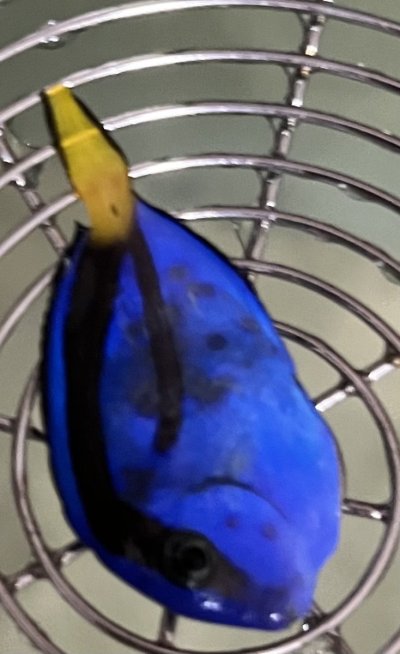Navigation
Install the app
How to install the app on iOS
Follow along with the video below to see how to install our site as a web app on your home screen.
Note: This feature may not be available in some browsers.
More options
You are using an out of date browser. It may not display this or other websites correctly.
You should upgrade or use an alternative browser.
You should upgrade or use an alternative browser.
Help
- Thread starter Nicholas234
- Start date
- Tagged users None
vetteguy53081
Well known Member and monster tank lover
View Badges
Partner Member 2024
Excellence Award
Reef Tank 365
RGB
Article Contributor
Tampa Bay Reef Keepers
West Palm Beach Reefer
Hospitality Award
Ocala Reef Club Member
305 Reef Club
Wisco Reefers
Midwest Reefer
Fish Medic
MAC of SW Florida
Rock Pool Reef Keepers
R2R Secret Santa 2023
My Tank Thread
My Aquarium Showcase
Its hard to see with fish out of water and on a metal strainer, if it flaps can do damage but to address your concerns, it is either bacterial or what I believe is hyper-melanization which originates from a sting from anemone or euphyllia coral. Other would be punctures from an urchin but hard to tell with fish out of water
So what would you recommend to do other than remove the anemoneIts hard to see with fish out of water and on a metal strainer, if it flaps can do damage but to address your concerns, it is either bacterial or what I believe is hyper-melanization which originates from a sting from anemone or euphyllia coral. Other would be punctures from an urchin but hard to tell with fish out of water
Welcome to Reef2Reef!
With spots just on one side, that does lean towards a coral or anemone sting - parasites almost always attach to a fish in a random fashion. Spots on one side but not the other isn't random.
Fish sometimes learn to stay away from the corals and anemones causing the stings, but really, fish don't have strong pain receptors, so they don't learn from being stung like mammals do.
What species of anemone do you have?
Jay
I have a bubble tip anemoneWelcome to Reef2Reef!
With spots just on one side, that does lean towards a coral or anemone sting - parasites almost always attach to a fish in a random fashion. Spots on one side but not the other isn't random.
Fish sometimes learn to stay away from the corals and anemones causing the stings, but really, fish don't have strong pain receptors, so they don't learn from being stung like mammals do.
What species of anemone do you have?
Jay
Is the fish showing any other symptoms?I have a bubble tip anemone
Jay
No, it’s actually gotten better thank you for the helpIs the fish showing any other symptoms?
Jay
It died In going to quit what do I do with my stuffWelcome to Reef2Reef!
With spots just on one side, that does lean towards a coral or anemone sting - parasites almost always attach to a fish in a random fashion. Spots on one side but not the other isn't random.
Fish sometimes learn to stay away from the corals and anemones causing the stings, but really, fish don't have strong pain receptors, so they don't learn from being stung like mammals do.
What species of anemone do you have?
Jay
Similar threads
- Replies
- 2
- Views
- 149
- Replies
- 19
- Views
- 430
- Replies
- 20
- Views
- 394
- Replies
- 5
- Views
- 109
















